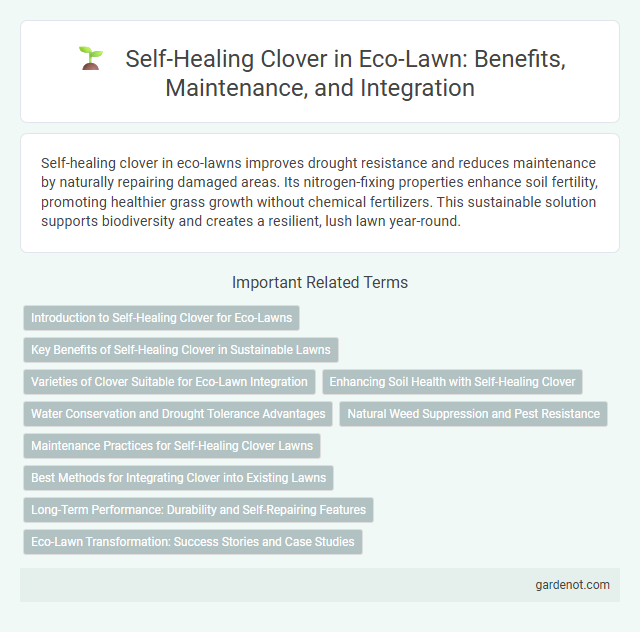Self-healing clover in eco-lawns improves drought resistance and reduces maintenance by naturally repairing damaged areas. Its nitrogen-fixing properties enhance soil fertility, promoting healthier grass growth without chemical fertilizers. This sustainable solution supports biodiversity and creates a resilient, lush lawn year-round.
Introduction to Self-Healing Clover for Eco-Lawns
Self-healing clover offers a sustainable solution for eco-lawns by enhancing soil nitrogen levels naturally, reducing the need for synthetic fertilizers. Its robust growth and natural resilience support drought tolerance and pest resistance, helping maintain a lush, green lawn with minimal maintenance. Integrating self-healing clover into eco-lawns promotes biodiversity and improves soil health, making it an ideal choice for environmentally conscious landscaping.
Key Benefits of Self-Healing Clover in Sustainable Lawns
Self-healing clover enhances sustainable lawns by naturally fixing nitrogen, reducing the need for synthetic fertilizers and promoting healthier soil. Its dense growth suppresses weeds, minimizing chemical herbicide use and supporting eco-friendly lawn care. The resilient nature of self-healing clover improves drought tolerance, ensuring green, lush lawns with lower water consumption.
Varieties of Clover Suitable for Eco-Lawn Integration
Self-healing clover varieties such as Trifolium repens (white clover) and Trifolium pratense (red clover) are ideal for eco-lawn integration due to their nitrogen-fixing properties and resilience. White clover is particularly favored for its low growth habit, durable turf-like appearance, and ability to regenerate quickly after damage, making it perfect for sustainable lawns. Red clover, while taller, enhances soil health and provides vibrant blooms that support pollinators within eco-friendly landscaping.
Enhancing Soil Health with Self-Healing Clover
Self-healing clover enhances soil health by naturally fixing atmospheric nitrogen, enriching the soil without synthetic fertilizers. Its deep root system improves soil structure, promotes aeration, and increases moisture retention, supporting robust lawn growth. The ability to recover from damage quickly reduces soil erosion and maintains a sustainable, vibrant eco-lawn environment.
Water Conservation and Drought Tolerance Advantages
Self-healing clover in eco-lawns significantly enhances water conservation by reducing irrigation needs through its deep root system that retains moisture efficiently. Its exceptional drought tolerance ensures persistent green coverage even under prolonged dry conditions, minimizing lawn maintenance and water consumption. Integrating clover into turfgrass also improves soil health by fixing nitrogen naturally, further reducing the reliance on artificial fertilizers and water inputs.
Natural Weed Suppression and Pest Resistance
Self-healing clover in eco-lawns enhances natural weed suppression by rapidly filling bare patches, preventing invasive species from establishing. Its pest-resistant properties reduce the need for chemical treatments, promoting a healthier lawn ecosystem. This resilient plant thrives in various conditions, maintaining lawn vigor while supporting biodiversity.
Maintenance Practices for Self-Healing Clover Lawns
Self-healing clover lawns require minimal watering and mowing, as clover thrives with natural rainfall and grows lower than traditional grass. Regular mowing at a high setting encourages dense growth and reduces weed invasion, while avoiding over-fertilization prevents excessive nitrogen that can harm clover health. Periodic aeration improves soil oxygen levels and promotes robust root development, enhancing the lawn's natural resilience and self-healing properties.
Best Methods for Integrating Clover into Existing Lawns
Planting self-healing clover in existing lawns improves drought resistance and reduces fertilizer needs by naturally fixing nitrogen. The best methods include overseeding during early spring or late fall, ensuring soil pH between 6.0 and 7.0 for optimal growth. Mowing at higher heights, around 3 inches, encourages clover establishment and minimizes competition with grass species.
Long-Term Performance: Durability and Self-Repairing Features
Self-healing clover in eco-lawns enhances long-term performance through its exceptional durability and natural self-repairing features. This resilient ground cover withstands foot traffic and environmental stress while continuously regenerating by filling in bare spots with new growth. Its ability to fix atmospheric nitrogen promotes soil health, reducing the need for synthetic fertilizers and ensuring sustained lawn vitality.
Eco-Lawn Transformation: Success Stories and Case Studies
Self-healing clover significantly enhances Eco-Lawn transformation by naturally repairing bare spots, reducing weed invasion, and improving soil nitrogen levels, which promotes sustainable lawn health. Case studies demonstrate lawns with self-healing clover achieve up to 40% less water usage and 30% fewer fertilizers compared to traditional grass lawns. Success stories highlight improved lawn resilience in urban and drought-prone areas, validating self-healing clover's role in eco-friendly, low-maintenance landscaping.
Self-healing clover Infographic

 gardenot.com
gardenot.com